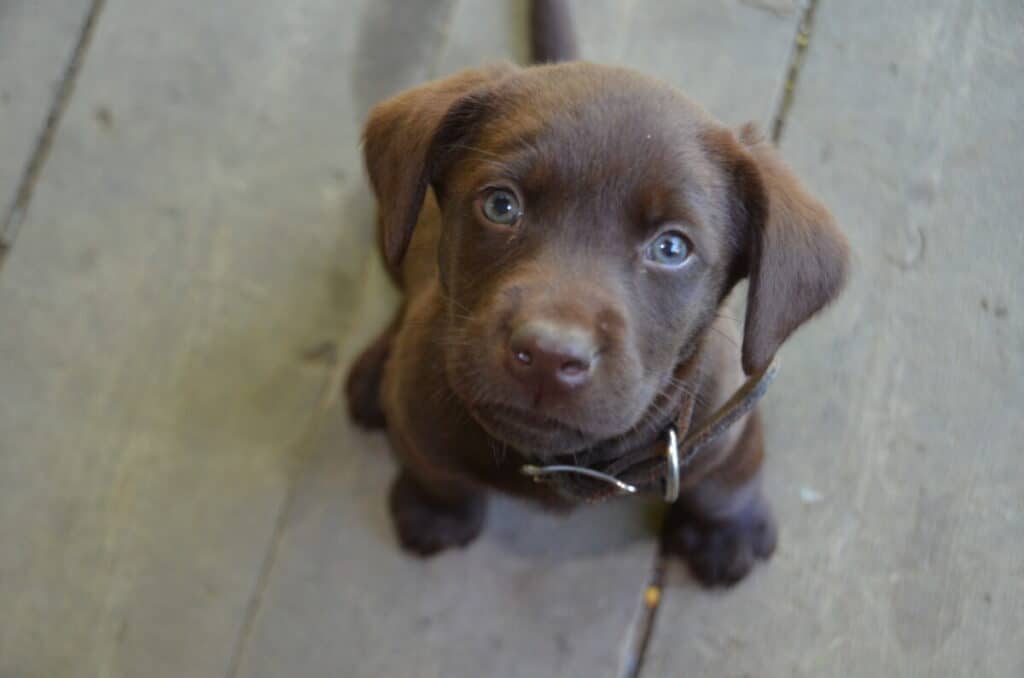Affiliate Disclosure: This post may contain affiliate links. If you make a purchase after clicking on these links I will be compensated at no extra cost to you. However, I never recommend anything I don’t love or wouldn’t use myself!
Puppies need a lot of care and protection including protection against fleas. However, being that puppies are so small and sensitive, you may wonder which flea treatments are puppy friendly, when to apply them, and how often? This article will endeavor to answer those questions and more.
When Can Flea Medication Be Applied to a Puppy?
Generally speaking, it’s a good idea to start treating your puppy for fleas at the same time that they start going outside at around eight weeks. Fortunately, this is also when most treatments become safe to use.
Most topical flea treatments can be used safely on puppies that are at least seven or eight weeks old, as long as they weigh five lbs or more and are healthy. However, certain oral flea treatments can only be administered once puppies have reached fourteen weeks or six months of age.
Nonetheless, you should always check the guidelines for the specific product that you are using.
You can check one of the tables later in the “Puppy Friendly Flea Medications” section of this article to find out which medications are safe to use and at which age or bodyweight.
If the medication you are using does not appear in the table, the same information can usually be found on the packaging of the flea treatment.
There may be other factors such as certain medical conditions that can make flea medications unsafe for some dogs.
Before you give your puppy any flea medication, check with your vet and make sure that your puppy is ready to receive it. Your vet will also be able to advise which flea medications are best suited to your needs.
How Often Do Puppies Need Flea Treatment?
There are many different ways to treat a puppy for fleas. How often you treat them is totally dependant upon the method you choose.
Typically, puppies should be treated for fleas as frequently as adults. Below is an overview of some of the most popular treatments.
How Often to Flea a Puppy:
| Route of puppy flea treatment | How often to apply/administer |
| Shampoo | 2 weeks* |
| Topical/Spot-on | 4 weeks |
| Spray | 4 weeks |
| Tablet/Chewable | 4 to 12 weeks |
| Collar | 3 to 8 months |
As a general rule, topical and spray flea treatments should be applied to puppies once every four weeks for the best protection. However, certain tablets can last up to three months and collars up to eight months.
Although I have included shampoo in the table above, it’s not recommended to use shampoos as a primary means of flea prevention, especially for young puppies.
While shampooing can be a good tool for killing off an infestation, it’s not the most effective preventative measure, and using it strips away puppies’ natural protective skin oils.
Additionally, in my experience, although collars typically boast the longest effective duration on paper, many are not as effective as other routes of flea prevention.
Puppy Friendly Flea Medications
When you are purchasing flea medication for your puppy, you’ll need to make sure that it’s suitable for their age.
Generally speaking, after puppies are eight weeks old, they can start using flea medications that are meant for adult dogs. However, if your puppy has any other medical conditions this can differ.
Check the tables below to see some popular flea medications that can be used on puppies. You can see the age and weight restrictions for each product so you can tell which treatment to use depending on your puppy’s age, along with how often to reapply the treatment.
The green and red names indicate whether the treatment is also effective against ticks.
Non-prescription Flea Medications:
| Flea Product | Age (min.) | Weight (min.) | Frequency |
| Advantage II Topical | 7 weeks | 3 lbs / 1.36 kg | Monthly |
| Capstar Tablet | 4 weeks | 2 lbs / 0.91 kg | See Package |
| Frontline Plus Topical | 8 weeks | 5 lbs / 2.27 kg | Monthly |
| Frontline Spray | 8 weeks | N/A | Monthly |
| K9 Advantix II Topical | 7 weeks | 4 lbs / 1.81 kg | Monthly |
| Seresto Collar | 7 weeks | N/A | 8 Monthly |
| Vectra 3D Topical | 8 weeks | 5 lbs / 2.27 kg | Monthly |
Prescription Flea Medications:
| Flea Product | Age (min.) | Weight (min.) | Frequency |
| Bravecto Chewable | 6 Months | 4.4 lbs / 2 kg | 3 Monthly |
| Comfortis Chewable | 14 weeks | 5 lbs / 2.27 kg | Monthly |
| Revolution (Puppy & Kitten) Topical | 6 weeks | 5 lbs / 2.27 kg max. | Monthly |
| Revolution (Standard) Topical | 7 weeks | 5 lbs / 2.27 kg | Monthly |
| Sentinel Flavor Tabs Tablet | 4 weeks | 2 lbs / 0.91 kg | Monthly |
| Trifexis Chewable | 8 weeks | 5 lbs / 2.27 kg | Monthly |
Are Fleas Common for Puppies?

Unfortunately, fleas are common when it comes to dogs and puppies alike. Fleas are abundant in many areas and puppies are very curious.
They often come into contact with these irritating creatures while they explore the outside world.
Alternatively, fleas can be brought home and introduced to them by other animals or even people.
Most dogs will have fleas at least once in their lifetime unless you keep up with their flea medication.
Luckily for both the dogs and their humans, fleas are easy to prevent as long as you stay up to date with flea treatments.
You just have to find a medication that works, and there are many flea medications on the market today that work well.
What Happens if Fleas Are Left Untreated on a Puppy?
If fleas are left untreated, they will continue to multiply quickly and before you know it you may have a severe infestation on your hands.
Flea eggs and larvae will be deposited all over your home making them more difficult to get rid of.
A bad flea infestation can be a serious issue as fleas can quickly make your dog become very ill.
As puppies are so small and their organs may not be so well developed, they can be more susceptible to illness as a result of fleas.
Fleas can cause a number of issues in dogs that include:
- Flea allergy dermatitis (FAD)
- Flea-bite anemeia
- Tapeworms
- Bartonellosis
If your puppy has fleas, you need to get rid of them as soon as possible. They don’t go away on their own, and they can seriously harm your dog if they are not treated.
How to Tell If Your Puppy Has Fleas
It is very important that you know if and when your puppy has fleas so you can get rid of them quickly. Luckily, it is usually fairly easy to tell whether or not your puppy has fleas.
Symptoms that Your Puppy Has Fleas:
- Excessive scratching/licking/gnawing
- Excessive head shaking
- Flea bites/scabs
- Irritated skin
- Fur/hair loss
- Yeast/bacterial infections
- Bumpy skin
- Dry skin
- Skin infections
- Ear infections
- Flea dirt on their skin
The red bumps on your dog’s skin will likely appear in places such as their armpits, groin, belly, around the base of their tail, and the underside of their ear flaps.
If your dog is a little bit itchy from time to time, this can be normal. However, if they seem to be excessively itchy, they likely have fleas.
Keep an eye on how often your dog scratches and bites itself so you can notice these changes in its behavior.
If you see your puppy showing any of the symptoms that are listed above, check them for fleas and you will more than likely find some.
How to Look for Fleas
When you are looking for fleas, have your puppy lay down and stay in one place. Admittedly this can be a difficult task for puppies!
You can pet them and give them treats if that helps them stay still. While you are looking through your pet’s fur, they will likely think that you are petting them and may enjoy it.
Part your dog’s fur and look for dark specks or tiny insects.
Look in the areas that I previously mentioned, such as their armpits, groin, belly, and the underside of their ear flaps. It’s easier to spot fleas in these locations too as there is not so much dense fur for them to hide amongst.
When you are searching through your dog’s fur for fleas, you may see adult fleas scurry away or see some cocooned or hatched larvae.
If you see small dark spots or black flecks that look very similar to pepper grounds, these are often flea feces, otherwise known as “flea dirt.”
Because of this, and the chance that you will come across flea larvae, you may want to wear rubber gloves that can easily be thrown away.

How to Get Rid of Fleas on Puppies
The way in which you treat your puppy for fleas depends upon exactly how old they are.
Bathing
Ideally, if your puppy is old enough, you should bathe them to regain some sanity as soon as possible.
Flea shampoos work well as they can help to repel fleas even after your pet has been washed. However, you can use pretty much anything that produces a lather to effectively drown fleas.
Just bear in mind that you should never bathe a puppy that is less than four or five weeks old. Young puppies are unable to regulate their body temperature at this age so washing them can be very risky.
In fact, most professionals recommend waiting until your puppy is 10 weeks old before bathing them, however, you may need to consider the risk of bathing your puppy versus the risk that the fleas impose.
If you decide to wash a puppy that is less than 10 weeks, baby shampoos or oatmeal shampoos are some of the safest to use on younger puppies. You can also use a shampoo that is formulated specifically for puppies. The label should tell you the ages that it is suitable for.
After your dog is done with its flea-killing bath, dry them off with a towel. If your dog is old enough, when they are fully dry, you should apply flea treatment to prevent the fleas from returning.
Flea Combs
You can use a flea comb (or any comb that has close enough teeth) safely at any stage in a dog’s life.
While this may not be as effective as other treatments including bathing, it’s a safe bet and sometimes the only option available to you if your puppy is very young.
Start at the head around the ears and work down the neck, ensuring you cover the entire body down to the tail.
On the plus side, puppies that are not old enough for the bath are not too big so it shouldn’t take you too long!
When you comb the fleas out, squash them with your fingernails or put them in a bowl of boiling water or dish soap to make sure they are dead.
If they are not dead when you remove them from your puppy, they can spread back through your house and find their way onto your puppy again at some point.
It is important for your puppy to avoid any infested bedding once they have been treated.
Treat the mother
If your puppy has fleas and they are still getting milk from their mother, give the mother an anti-flea medication that is safe for lactating mothers.
If you give them an unsafe medication, this could change the mother’s milk in a way that is not healthy for the puppies to drink.
If you are not sure which anti-flea medications are safe for lactating mothers, ask your veterinarian for product recommendations.
They can tell you what medication to give her and give you tips on how to get rid of the fleas in your situation.
Treat other household pets
If you have multiple dogs or animals but you only find fleas on one of them, make sure you treat them all for fleas.
You may not see fleas on them now but the last thing that you want is for the fleas to leave one pet and infest another so the cycle starts all over again.
What to Do to Your Home if You Find Fleas

Fleas spread quickly. If your pets have them then many of their eggs will have inevitably dropped off all-around your home.
Most people don’t notice eggs before it is too late because they are so small and are really hard to see.
If you find fleas on any of your animals, you’ll need to wash all their bedding and any upholstery they spend time in.
Use a hotwash in the washing machine as cold water will not work. Tumble drying will also kill fleas off at any point in their lifecycle due to the hot temperature.
If you can find an anti-flea laundry detergent that you are comfortable using, use it on the dog bedding and any of the blankets that they regularly use.
You will also need to go to all of your dog’s favorite spots and clean thoroughly. Vacuuming is very effective, puppy friendly, and readily available to most households.
Vacuum all of your carpets and furniture to suck up all of the fleas, eggs, and larvae that may be hiding. Do this daily for up to two weeks to make sure you get all of them.
After you finish vacuuming each day, empty out your vacuum in your outside trash can.
One natural way to get rid of fleas and their larvae is to spray lemon spray on all of your carpet and furniture or pour baking soda on all of your carpets. Do not do both as the baking soda will dissolve into the carpets and be impossible to remove.
However, even if you use a lemon spray or baking soda, you will still have to vacuum every day for a while.
After you get rid of your dog’s fleas, keep an eye on how itchy they are and the red bumps that are leftover from the fleas. If the bumps seem to be irritated, contact your vet and ask them for advice to avoid them from becoming infected.
Also, keep an eye out for evidence of fleas in your house, on your family members, and your dogs. Fleas affect both dogs and humans and can be detrimental to the health of both species.

